
What Is: A Covered Tight End/Receiver

This drove us nuts against UCF:
This drove us nuts against Colorado:
This shouldn’t be happening. To understand why we have to go back to the rules of football.
Ends and Backs
Football evolved from a rugby-like game, with forward passing added almost a generation later. The running sport and the passing sport never perfectly coalesced into one—even today there are offenses that treat their quarterback as a primary rusher or primarily a passer. You can also trace the problem of linemen blocking downfield on passing plays back to this awkward marriage of two games. So they had to make rules: You can block here but not there. The rule that matters to us is this guy is an eligible receiver and that guy isn’t.

[After THE JUMP: What’s a legal formation, why teams do this, and a jazzy snazzy video]
A legal formation has four guys in the backfield and seven who must be on the line of scrimmage (to outlaw the brutal wedge formations that literally got players killed).
Of these eligible receivers are:
- Anyone lined up 1 yard or more in the backfield
- Whoever the last guy is of those on the line of scrimmage
- Anyone in position to receive the snap (i.e. the quarterback)
And there are limits.
- You can only have five eligible receivers plus a quarterback.
- Non-eligible receivers (i.e. linemen) can’t go downfield more than 3 yards (college) or 1 yard (pro) from the line of scrimmage on a pass play.
- Eligible receivers must wear an eligible receiver number: 1-49 or 80-99.
This was all sensible given the typical formation of the day looked like 1904 Michigan here:
[courtesy of UM Bentley Library]
However, today the typical offense lines up more like this:
As the passing game evolved, offenses started to use any eligible receiver and put him “wide” to take advantage of their athletic abilities and drag defenders away from the run action. Ends split out (“split end”) or remained tight to the formation, and various backs also lined up in ways that made their horizontal position (the “slot” or “flanker” etc.) more apparent than how far they lined up from scrimmage.
And so position names today bare little relation to the actual positions. And confusingly, we regularly assign the position names that are meant to denote alignment to players regularly assigned that position, e.g. we call this guy a “Tight End in Motion”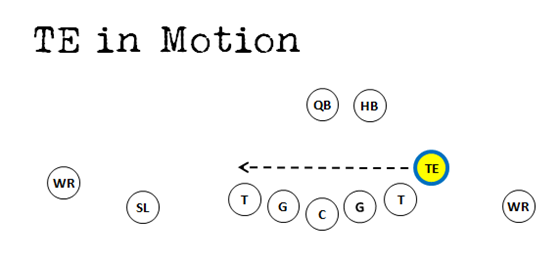
Despite that phrase being an oxymoron. Still, all offenses must observe the basic rules.
Covering: When an End is Not an End
The rules don’t care where you are horizontally. If somebody is lined up outside the guy you think of as an end, no matter how far, the inside guy isn’t an end anymore.
I made the guard gray to denote the middle guy on the line of scrimmage. Our modern terms and minds are trained to call the covered guy a tight end, and certainly the guy standing there is a “tight end” on the roster. But the rules of football still see these guys thusly:
The “tight end” is thus “covered” by having the slot receiver standing around outside of him.
Let’s go back to the Colorado play.
The covered tight end doesn’t totally act like he’s covered. He takes two steps out like he’s going into a pattern after all, and carefully stays juuuuust inside the 3-yards from the line of scrimmage he’s allowed to be in (this is never called anyway), so he can block McCray.
After some play-action to bring the linebackers down, Colorado is going to put Peppers in a pickle, since he has to respect the bubble action of that H-back on the top hash, and will thus let the (blue route) slot receiver cut behind him for big yards before the safety to that side (Delano Hill) can react and come down. How is Michigan supposed to deal with this when there are so many receivers on that side?
Well Jeremy Clark and Dymonte Thomas might help. Clark is the guy at the bottom-left, hanging out at the top of the “B” of B1G. Dymonte Thomas is also on that side, guarding the edge from between the “1” and “G”. Whom do they wind up covering? NOOOOOOOOBODY!
Don’t hold me to that coverage—as Ace pointed out in Slack today, people who know way more about football than I do have trouble ID’ing coverages even after they’re on tape:
We asked 3 NFL coaches to ID a coverage & received 3 different answers @davearchie on why it so hard to ID coverageshttps://t.co/yXMBvnykaP pic.twitter.com/lWx5mx6HRP
— Inside the Pylon (@ITPylon) September 20, 2016
Why Teams Do This
The disadvantage of one fewer receivers for the defense to worry about has to be overcome by something, or else why would you do that to yourself? There are reasons.
First of all because it sows confusion, and that’s especially true for when you’re a tempo team that uses practice time to get defenders lined up incorrectly or in bad matchups. You may catch them off guard, as Colorado and UCF did in the above examples. Plus now the defense has to check for covered receivers in addition to all the other stuff you’re throwing at them before the snap.
Another reason is to get back what the rules of football take away by forcing one receiver to always be on the backside. Lots of coaches (Harbaugh is certainly one of them) like to put as many receivers to one side of the formation as possible. All those passing targets to one side are tough for defenders to keep track of, and all of those help defenders are now missing from the other side. Remember how one of the troubles with outside runs is cornerbacks out there to force it inside? Imagine if that guy isn’t even out there!
Ross Fulton of Buckeyegrove wrote an excellent piece on the games OSU played with Oklahoma’s defense last Saturday and one of them was covering a receiver on one side for this purpose:
The Buckeyes next featured an unbalanced formation to free Mike Weber on tight zone and power. Meyer aligned three wide receivers and the tight end to the field – including covering up one wide receiver.
This pulled Oklahoma to the unbalanced side – leaving the Sooners with only three defenders past the centerline and removing the weak side force support. Ohio State then ran split zone and power to the boundary. Weber could bounce runs outside, which he maximized with his quick feet in the hole.
It’s one more way to keep a defense guessing instead of attacking, and to put your players into matchups they can win. Covering has a cost, but a good offense will make it worthwhile, and a good defense will be ready to make them pay.
September 21st, 2016 at 11:51 AM ^
Sent from MGoBlog HD for iPhone & iPad
September 21st, 2016 at 11:56 AM ^
Same coverage, obviously there is a stunt up front that gets attention, but watch how the LBs react much better. They turn, get depth, find the receiver, and this play was shut down anyway.
September 21st, 2016 at 12:17 PM ^
I did notice that those stupid slants stopped being wide open after a while. Did that seem to be an adjustment we made in game where the linebackers figured out they needed to be getting depth quicker and that closed that window for Colorado?
September 21st, 2016 at 12:18 PM ^
It was specifically an adjustment after the first quarter if I recall. Brown also started calling more man coverage on early downs to just allow the coverage to stick to the receiver (thus avoiding the whole issue of LBs gaining depth after being put in a run/pass conflict early).
September 21st, 2016 at 12:13 PM ^
What is the point of having an intentionally covered receiver? I still don't get it. Take the Ohio State pic and the circled inelligable reciever. If he takes a couple steps back he's elligable and the play would've worked the same without the risk of Oklahoma adjusting their coverage. Why take the risk that the defense correctly ID'd whether he's elligable or not?
September 21st, 2016 at 12:17 PM ^
In this case, it would most likely be the move TE. With the move TE on the LOS, it limits OSU's run play book. Here, they run split zone. That split zone requires the TE to cross the formation and adds to their read option package (the TE can slip the block and move to the next level with a called QB keep or, if advanced, with a read). He can also run power easier in a position off the LOS. Having him off the LOS allows OSU to run more schemes with their blockers.
September 21st, 2016 at 2:44 PM ^
In that OSU play, their TE does an interesting thing. Instead of engaging the blocker which would have condensed the hole Weber was going to run through, he faked the block and then circled outside which took the defender with him opening up the hole better. Risky, because if the defender doesn't bite, then it looks like you missed the block, but it also looks like he was coached to do that.
September 21st, 2016 at 12:19 PM ^
Wouldn't that give you 5 men in the backfield? QB, RB, 2 WRs and a TE?
September 21st, 2016 at 12:33 PM ^
Ah, yup, that explains it. Thanks to you (and Space Coyote) for the reply.
Man, it really makes you appreicate the refs that have to keep up with all this stuff.
September 21st, 2016 at 12:59 PM ^
That formation by colorado is asking for quarters 2 read coverage by the corner and Deep Safety. Meaning they read the second receiver and if he goes vertical then the deep safety takes him in man and the corner takes the first reciever in man. Peppers takes the flat which means he ends up on number 3. The deep safety to the other side of the field needs to cheat over to be able to defend number 3 on a vertical route.
That being said I don't know if Quarters 2 read coverage is a part of Don Brown's schemes but that would work well for situations like the one Colorado presented us.
September 21st, 2016 at 12:31 PM ^
With the LT aligned next to the RT you'd have better blockers playside and an eligible reciever (due to jersey number) and likely lesser talented blocker available for a backside route?
September 21st, 2016 at 12:48 PM ^
That's called an "Unbalanced Line" and offenses do that too. However you lose the surprise. Defenses can fall asleep sometimes and forget to look to see if the man they're lined up over is covered. But it's harder to miss a tight end lined up next to a guard.
September 21st, 2016 at 12:56 PM ^
Also the fact that you may want to run left here. And if you want to maintain that threat, running weakside with only a TE and OG on that side is going to be more difficult to accomplish. There are positives and negatives to both. In this case, the goal of the TE is to pass block only long enough to not be an illegal man downfield and then sprint down field and try to pick off a LB or safety to help the run after catch. So you're really looking to have a faster player there then a better blocker
September 21st, 2016 at 1:09 PM ^
Would this TE then become an eligible receiver since his number is not a lineman's?
September 21st, 2016 at 1:17 PM ^
Then yes, he would be eligible to be a receiver.
September 21st, 2016 at 1:28 PM ^
Sent from MGoBlog HD for iPhone & iPad
September 21st, 2016 at 1:41 PM ^
There is a WR (the second WR from the top) that is on the LOS, thus "covering" the TE and making him ineligible.
September 22nd, 2016 at 7:34 AM ^
September 21st, 2016 at 1:37 PM ^
Not to be snarky... but for a post titled "What is: a Covered Tight End/Receiver," I still can't figure out what the definition of 'covered' actually is after reading through this a couple times.
As I read it, the term seems to refer to a player who's position implies he's normally eligible to catch a pass but instead is actually ineligible based on the number of guys on/off the LoS. Or is it the relative position of guys on/off LoS? Or jersey number?
Too many different things going on simultaneously... can someone try to give a definition of 'covered' so I can have some context as I read this again? Sorry, clearly not well versed in this stuff.
Thanks for taking the time to explain.
September 21st, 2016 at 1:45 PM ^
Eligible receivers include anyone lined up off the LOS and the outer most guys lined up on the LOS. Regardless of what the formation looks like, the last guy on the LOS that is nearest the sideline is an eligible receiver (unless they have a jersey number that makes them ineligible).
These eligible receivers on the LOS are "uncovered". Anyone lined up between these outer most guys is considered "covered" by the guy further outside, and these "covered" guys are automatically ineligible receivers.
The term is used, in this instance, for a TE. The TE is a position that is typically eligible to be a receiver, but in this case, the fact that he is covered, makes him ineligible.
September 21st, 2016 at 2:45 PM ^
A "Covered" TE or WR is a guy ON THE LINE OF SCRIMMAGE who has another guy OUTSIDE of him on the line of scrimmage. Only the guy furthest out on the line of scrimmage to each side is an eligible receiver. Ignore anyone not on the line of scrimmage (even if they're just a yard back)
If you're covered all the rules for offensive linemen apply to you, e.g. you're not an eligible receiver.
September 21st, 2016 at 3:00 PM ^
Ahh, thanks for the clarification @Seth and @Space Coyote.
That was the piece I was missing:
"A "Covered" TE or WR is a guy ON THE LINE OF SCRIMMAGE who has another guy OUTSIDE of him on the line of scrimmage."
and
"Anyone lined up between these outer most guys is considered "covered" by the guy further outside, and these "covered" guys are automatically ineligible receivers."
September 21st, 2016 at 2:04 PM ^
This was very informative. Thanks!
September 21st, 2016 at 2:58 PM ^
Awesome write up! Thank you.
Eligibility is determined prior to the play, correct? Meaning the refs can determine a player's eligibility prior to the pass and not based on what his objective is.
All help appreciated. Good stuff.
September 21st, 2016 at 3:31 PM ^
It's how you line up. If you're in the backfield you're eligible unless your number isn't. If you're one of the seven guys on the line, you have to be on either end to be eligible. It's not the refs going "this guy this guy this guy" for the same reason it's not the umpires saying "Batter #2 has to go after Batter #1. It's the core rules of the game. If the offense has more than 4 guys in the backfield (or as it's written in the NFL, 7 guys on the line of scrimmage) it'll be an illegal formation. That often gets called when a wide receiver isn't on the line like he's supposed to be, or when OTs line up over a yard back to help with pass pro (linemen will always push that--Spurrier's teams were famous for it).
Also you have to have 5 guys with legal numbers on the line. So you can't have an OT run out and change his shirt without putting someone else with a lineman number on the line. Remember when Mags played tight end in 2014 he wore 81 but there were still 5 other guys with eligible numbers for linemen.
September 21st, 2016 at 3:48 PM ^
Beautiful. I appreciate the response.
For me I think the confusing element comes from some of the leeway that's giving in terms of "being on the line." The eligible receivers are often only a step behind (it seems) which makes some of the variations in these formations more confusing/not as easy to identify.
Again, thanks for the reply.
September 21st, 2016 at 6:30 PM ^
September 22nd, 2016 at 8:44 AM ^
Was amazing, and the vid was a great visualization. Thanks Seth!
September 22nd, 2016 at 3:49 PM ^
I love mgoblog.com. I learn so much: rules, history, strategy, counter-strategy.
Feel enlightened I just donated $25.
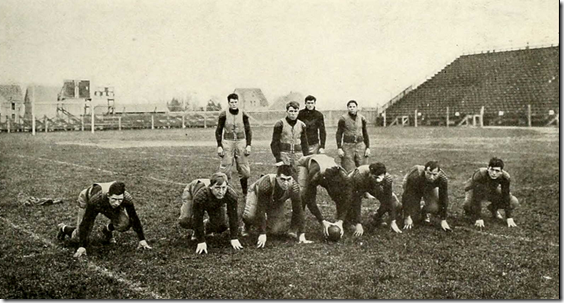

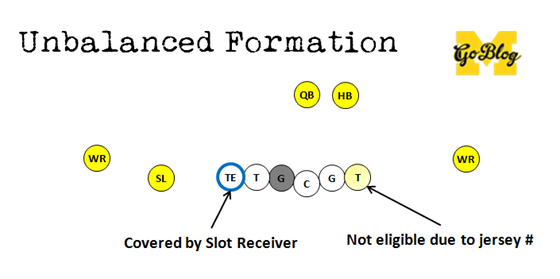
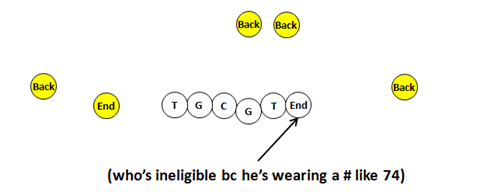
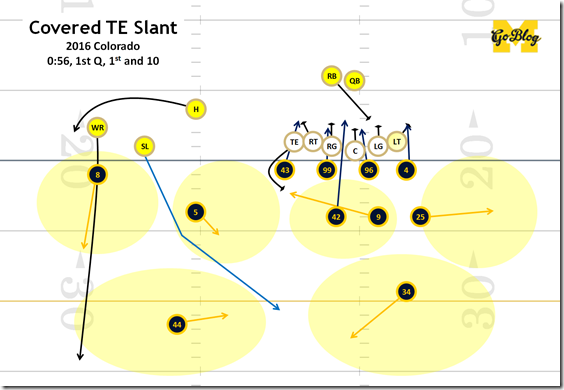

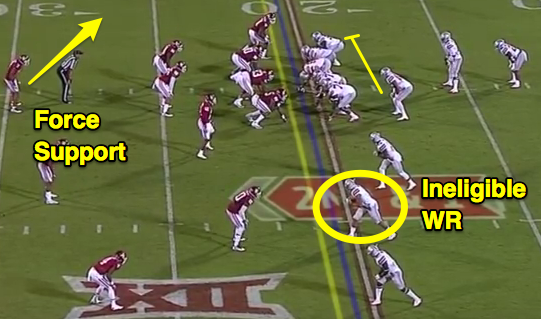
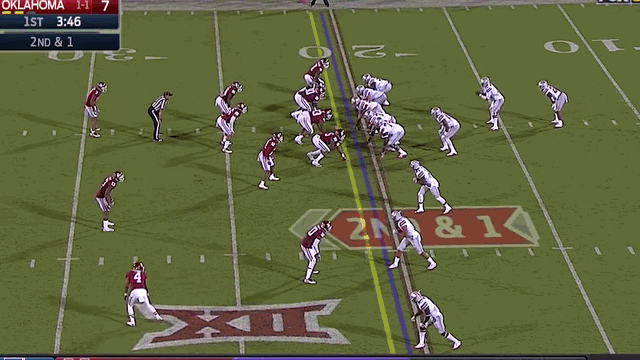
Comments